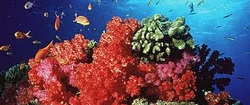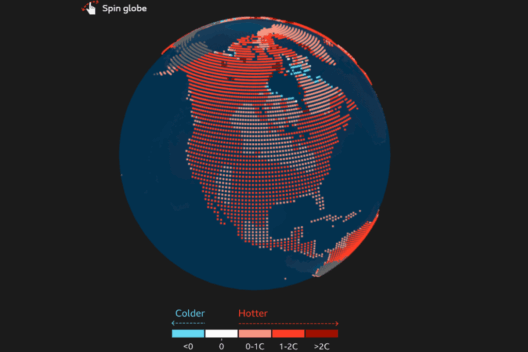Global warming, a pressing issue of our time, challenges the resilience of various ecosystems across the globe. But does it impact terrestrial life more than aquatic life? This question opens a portal to investigate the complex interactions and vulnerabilities among species in different habitats. To entice readers, we might ask, “If the land and ocean were in a race to adapt, who would be at the front of the pack?” The answer reveals vital insights into which ecosystems and species are most at risk.
To examine the ramifications of global warming, it’s integral to understand what it entails. Primarily driven by anthropogenic activities such as fossil fuel combustion, deforestation, and industrial processes, global warming leads to increased atmospheric temperatures and disruption of climatic conditions. These shifts are not merely statistical changes but translate into real-world consequences, including altered precipitation patterns, rising sea levels, and extreme weather events.
Terrestrial ecosystems encompass a vast range of biomes, from lush rainforests to arid deserts. Each biome hosts a myriad of species that have evolved to thrive within specific environmental parameters. However, the rapid rate of climate change threatens these delicate balances. Species that cannot adapt swiftly enough face extinction. Take, for instance, the polar bear, a quintessential emblem of climate change’s terrestrial impact. As Arctic ice diminishes, these magnificent predators find it increasingly challenging to hunt seals, their primary food source.
Conversely, aquatic ecosystems face their own set of alarming challenges. These habitats harbor countless species, ranging from microscopic phytoplankton to the majestic blue whale. Ocean temperatures are rising, and this warming has an adverse effect on coral reefs, which are highly sensitive to temperature fluctuations. Coral bleaching events, a direct result of elevated sea temperatures, have devastating consequences for the myriad species that rely on these underwater ecosystems for shelter and sustenance.
As we delve deeper, we must consider the specifics of the impacts on terrestrial versus aquatic life. Terrestrial organisms are generally more adaptable to fluctuations in temperature than their aquatic counterparts. For instance, many terrestrial plants can migrate or evolve over generations. Meanwhile, aquatic species often possess limited mobility, particularly those that are sessile or have a restricted range, making it difficult for them to adapt to changing conditions.
One might argue that some terrestrial species may benefit from global warming, as certain plants and animals could expand into previously inhospitable territories. However, this is misleading. The reality is that invasive species can outcompete native ones, leading to biodiversity loss and dysfunctional ecosystems. It is not simply a matter of survival; it is about the intricate web of interactions within ecosystems that is being severed.
In the aquatic realm, the story takes a darker turn. Ocean acidification, a byproduct of increased carbon dioxide levels, severely affects marine organisms that rely on calcium carbonate to build their shells and skeletons, such as mollusks and certain corals. As the oceans become more acidic, the survival of these species—and, by extension, the numerous species that rely on them—hangs in the balance. The consequence of this degradation is profound. Could we soon witness a future devoid of coral reefs and rich marine biodiversity?
The concept of resilience is pivotal in determining which ecosystems are most at risk. Research indicates that biodiversity itself enhances ecosystem resilience. As certain species diminish or disappear due to climate change, ecosystems lose their functionality and may fail to recover from disturbances. This is particularly glaring in both terrestrial and aquatic environments where keystone species—those that have a disproportionately large effect on their environment—are threatened or decline rapidly. When these species falter, the cascading effects can lead to catastrophic outcomes.
Among those most vulnerable to the inexorable march of climate change are amphibians. These creatures serve as bellwethers for environmental health due to their permeable skin and dual life stages. They require both terrestrial and aquatic habitats to thrive and, therefore, are exceptionally sensitive to environmental changes. Their declines signal larger issues in both environments, revealing a grim picture of interconnected vulnerability.
Bird species also demonstrate susceptibility to climate fluctuations. Habitat loss, altered migratory patterns, and changing food availability make them prime candidates for population decline. Moreover, as temperatures rise, many birds are moving their breeding grounds northwards, a phenomenon that could disrupt existing ecosystems and interactions among species.
In contrast, certain hardier species, such as cockroaches and dandelions, may thrive in changing conditions. This raises the question: Is our ecosystem becoming more homogenized as only a select few species flourish while others perish? The ramifications extend far beyond individual species—biodiversity loss threatens ecosystem services essential for human well-being, such as pollination, clean water, and carbon sequestration.
Ultimately, as we navigate this multifaceted dilemma, it becomes clear that both terrestrial and aquatic life face formidable challenges due to global warming. While terrestrial ecosystems may showcase certain adaptive advantages, aquatic habitats are under siege from a unique blend of threats that could lead to unparalleled losses in biodiversity. The true essence of coexistence lies in recognizing that each ecosystem plays a crucial role in the biosphere. In addressing climate change, we must seek holistic solutions that protect the delicate balance of life both on land and in water, ensuring a thriving planet for future generations.







